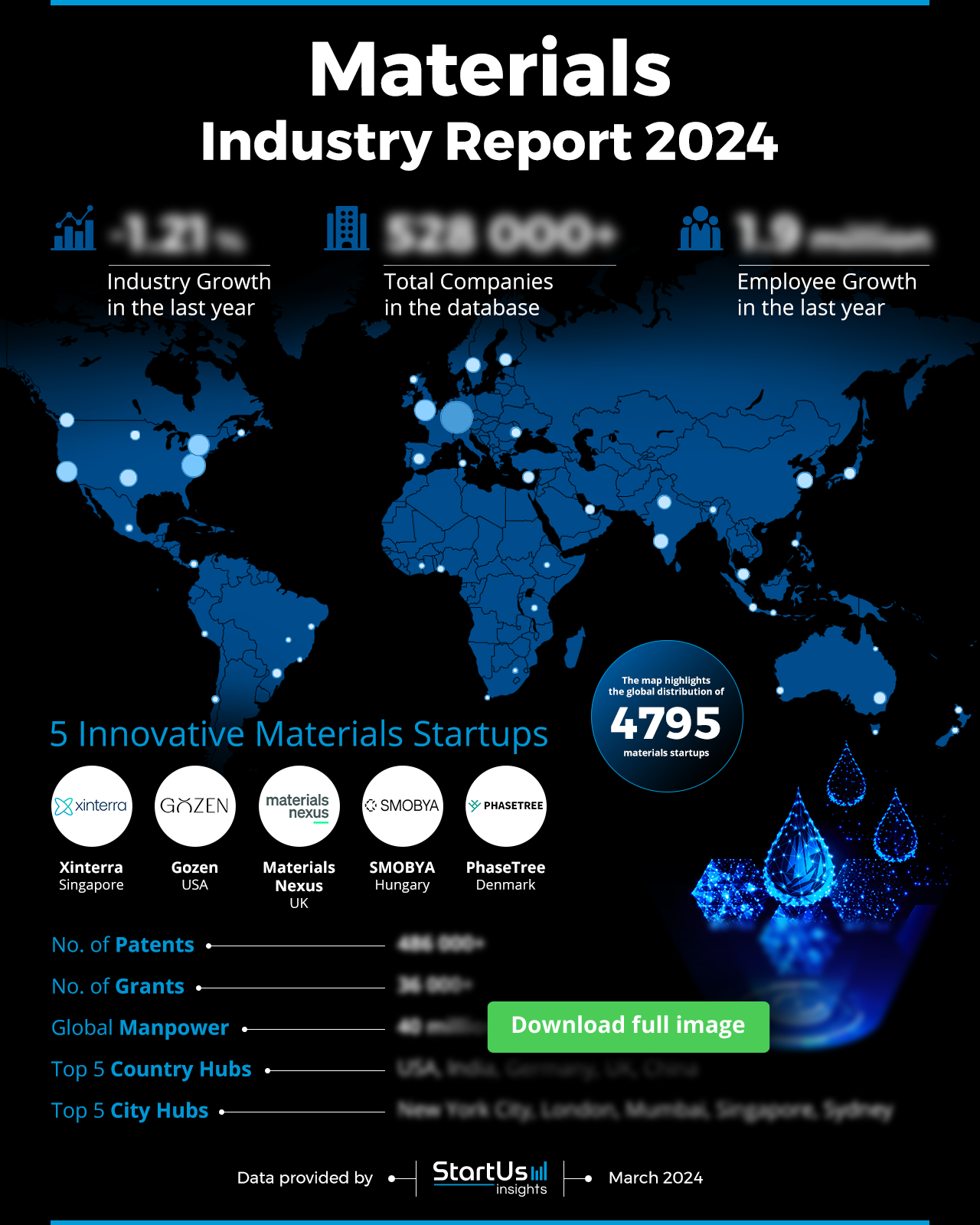This Materials Sector Outlook for 2024 presents a significant change and resilience, reflecting the sector’s response to global challenges and alignment with evolving market demands. With an emphasis on sustainability, innovation, and technological integration, the industry has navigated shifts towards more eco-friendly practices, advanced material applications, and the emergence of biomaterials and superconducting materials. This report provides an overview of the industry’s performance, highlighting key trends, investment patterns, and emerging startups.
This report was last updated in July 2024.
This materials industry report serves as a reference for stakeholders, investors, policymakers, and economic analysts, providing a snapshot of the industry’s health to map its trajectory for innovation and growth in the coming years.
StartUs Insights Materials Sector Outlook 2024
- Executive Summary
- Introduction to the Materials Industry Report 2024
- What data is used in this Materials Industry Report?
- Snapshot of the Global Materials Industry
- Funding Landscape in the Materials Industry
- Who is Investing in the Materials Industry?
- Emerging Trends in the Materials Industry
- 5 Materials Startups impacting the Industry

Executive Summary: Materials Industry Report 2024
This report is created using data obtained from the Big Data and AI-powered StartUs Insights Discovery Platform, covering more than 4.7 million global companies, as well as 20K+ technologies and emerging trends. We also analyzed a sample of 4000+ materials startups developing innovative solutions to present five examples from emerging materials industry trends.
- Industry Growth Overview: The materials industry experienced a slight decline of -1.21% in annual growth rate, with over 528000 companies listed.
- Manpower & Employment Growth: The industry employs over 40 million people, with an addition of 1.9 million employees in the last year.
- Patents & Grants: The sector’s commitment to R&D and innovation is evident with over 486000 patents and 36000+ grants,
- Global Footprint: It has key hubs in the USA, India, Germany, the UK, and China, including cities such as New York City, London, Mumbai, Singapore, and Sydney.
- Investment Landscape: The average investment value is USD 39 million, with more than 78000 funding rounds and 22000+ investors engaged.
- Top Investors: Investors such as Sequoia Capital, European Investment Bank, Tiger Global Management, and more have made significant investments, exceeding USD 13 billion in total.
- Startup Ecosystem: Highlights five innovative startups, Xinterra (Material Creation Platform), Gozen (Advanced Biomaterials), Materials Nexus (Net-Zero Materials), SMOBYA (Cellulose Manufacturing System), and PhaseTree (Material Discovery Simulations).
- Recommendations for Stakeholders: Invest in eco-friendly production and biomaterial research; adopt nanotechnology and AI to maintain a competitive edge; promote innovation by adopting or partnering with complementary solutions.
Explore the Data-driven Materials Industry Outlook for 2024
The materials sector outlook 2024 uses data from the Discovery Platform and encapsulates the key metrics that underline the sector’s dynamic growth and innovation. The industry has seen a slight contraction, with a -1.21% growth in the last year. Our database records a vast network of over 528000 materials companies globally. The sector’s manpower exceeds 40 million, underscoring the sector’s critical role in the global workforce. Employee growth remains steady with an increase of 1.9 million in the past year.
What data is used to create this materials industry report?
Based on the data provided by our Discovery Platform, we observe that the materials industry ranks among the top 5% in the following categories relative to all 20K topics in our database. These categories provide a comprehensive overview of the industry’s key metrics and inform the short-term future direction of the industry.
- News Coverage & Publications: The materials industry has a significant presence, with over 405000 publications in the last year.
- Funding Rounds: Our database contains data from more than 78000 funding rounds.
- Manpower: The industry employs a substantial workforce of over 40 million, with an addition of over 1 million new employees in the last year.
- Patents: The sector is notable for its innovation, holding more than 486000 patents.
- Grants: With 36000 grants received, the industry shows its commitment to research and development.
A Snapshot of the Global Materials Industry
The materials industry displays notable stability and development, as seen by its considerable manpower and the growing number of employees. With a workforce that has reached 40 million, the industry demonstrates its vast size and pivotal role in the global economy. This workforce has been further strengthened in the last year with an addition of 1.9 million employees, highlighting a dynamic sector that is steadily growing. The industry’s scope is emphasized by the presence of over 528000 companies, suggesting a diverse and competitive landscape.
Explore the Funding Landscape of the Materials Industry
The materials industry contributes to the global market, as shown by its investment and funding statistics. With an average investment value of USD 39 million, the sector attracts financial commitments. More than 22000 investors have engaged with the industry, indicating its ability to interest a diverse range of financial supporters. The industry’s growth and development are evident in the over 78000 funding rounds that have been closed. Further, more than 35000 companies have received investments.
Who is Investing in the Materials Industry?
The materials industry has seen notable financial engagement from top investors, with a combined investment value surpassing USD 13 billion.
- Sequoia Capital has invested in 46 companies, infusing USD 1.2 billion into the sector, demonstrating its commitment to promoting growth and innovation.
- The European Investment Bank has invested USD 1.6 billion across 30 companies, showcasing its support for the industry’s progress in Europe and beyond.
- Tiger Global Management has invested USD 1.2 billion in 32 companies, highlighting its proactive investment strategy in promising sectors.
- Goldman Sachs has invested USD 1.2 billion in 23 companies, showing its confidence in the industry’s potential.
- Warburg Pincus has allocated USD 1.2 billion to 23 companies.
- SoftBank Vision Fund has made an investment of USD 1.6 billion in 10 companies, betting big on fewer, potentially high-impact ventures.
- General Atlantic has invested USD 1.1 billion in 26 companies, highlighting its strategy to support growth-stage companies.
- International Finance Corporation has contributed USD 1 billion to 22 companies, reinforcing its mission to promote private sector development in less developed countries.
- Qatar Investment Authority has invested USD 1.3 billion investment in 7 companies, showcasing its interest in diversifying its investment portfolio.
- Alibaba Group has strategically invested USD 1 billion in 5 companies, underscoring its intent to leverage the materials sector’s potential for its ecosystem.
These investments highlight the global confidence in the materials industry’s future, indicating a steady path forward driven by innovation and strategic financial support.
Explore Firmographic Data for All Materials Industry Trends
- The sustainable materials trend indicates a commitment to environmental stewardship and sustainability. A total of 3000+ companies are identified in this space. It employs 283000+ individuals, with an increase of 15000+ new employees in the last year alone. Further, it has an annual trend growth rate of 3.73%, highlighting the industry’s steady expansion and the increasing demand for environmentally friendly materials.
- In biomaterials, a total of 2000+ companies are identified. It has a global workforce of 139000+ employees, with an addition of 9000+ new employees over the last year. Further, it shows a robust annual trend growth rate of 6.37%. This surge reflects the sector’s crucial role in advancing healthcare, biotechnology, and sustainable products.
- The superconducting materials are used in applications such as MRI machines, particle accelerators, and electrical power infrastructure. A total of 29 companies are working on this trend. It employs more than 3600 employees with an addition of 130+ new employees last year. Further, it experienced an annual trend growth rate of -7.41%.
5 Top Examples from 4000+ Innovative Materials Startups
The five innovative startups showcased below are picked based on data including the trend they operate within and their relevance, founding year, funding status, and more. Book a demo to find promising startups, emerging trends, or industry data specific to your company’s needs and objectives.
Xinterra develops a Material Creation Platform
Singaporean startup Xinterra enhances materials R&D with its Xinterra Design Factory (XDF), a platform for real materials creation. The platform combines AI, domain expert intuition, and high throughput experimentation to achieve material formulations efficiently. This way, the startup investigates and adds new functionalities in materials at a quicker pace. With the integration of profound materials science knowledge, automated systems, and sophisticated AI techniques, XDF navigates and utilizes a wide parameter space for materials design effectively.
Gozen creates Advanced Biomaterials
US-based startup Gozen produces biomaterials for sustainable design by using microorganisms to make materials. LUNAFORM, its biomaterial’s strength is comparable to animal leather and comes entirely from bio-based sources. It has a distinct biophilic texture, a comfortable feel, and natural translucency, allowing customization from thin layers to thicknesses similar to leather. The startup focuses on efficiency and scalability, making materials in large sheets for various design applications. This also makes it easier to integrate into existing supply chains, supporting a shift toward circular production in the fashion and automotive industries.
Materials Nexus produces Net-Zero Materials
UK-based startup Materials Nexus transforms the material design and discovery process using advanced AI technology, creating novel, superior materials quickly and efficiently. It involves the rapid exploration of the periodic table and modeling new material properties to accelerate discovery. The startup targets the production of next-generation materials that are accessible, environmentally friendly, and high-performing. Materials Nexus addresses the significant social, environmental, and economic costs related to conventional materials.
SMOBYA builds a Cellulose Manufacturing System
Hungarian startup SMOBYA produces sustainable biomaterials of good quality using its NanoTwine™ technology. This technology converts food industry waste into nanocellulose sheets, which are then turned into biomaterials. The startup’s process involves fermentation, harvesting, coloring, surface treatment, and finishing with a biodegradable coating. SMOBYA’s materials replace damaging substances in the textile industry, supporting environmental sustainability.
PhaseTree provides Cloud-Based Material Discovery Simulations
Danish startup PhaseTree develops a collaborative online materials simulation platform. It enables a new multiscale modeling paradigm using AI. The platform includes Density Functional Theory (DFT), Cluster Expansion, CALculation of PHAse Diagrams (CALPHAD), and Phase Field. These components work together to predict microstructure evolution based on information from DFT and Cluster Expansion. PhaseTree focuses on applications in green energy, like battery electrodes and catalysts.
Gain Comprehensive Insights into Materials Trends, Startups, or Technologies
The 2024 materials sector outlook report highlights an evolving industry that prioritizes innovation, sustainability, and technological integration. Trends like sustainable materials, biomaterials, and advanced material technologies suggest a shift towards environmentally friendly and high-efficiency products. These developments hint at a future of the industry that includes enhanced performance, reduced environmental impact, and increased market opportunities. Get in touch to explore all 4000+ startups and scaleups, as well as all industry trends impacting materials companies.


![Packaging 4.0 : Top 9 Digital Transformation Technologies to Watch [2025]](https://www.startus-insights.com/wp-content/uploads/2025/02/Packaging-4.0-SharedImg-StartUs-Insights-noresize-420x236.webp)
![AI and Business: A Strategic Guide for Industry Leaders & Corporates [2025-2030]](https://www.startus-insights.com/wp-content/uploads/2025/02/AI-and-Business-SharedImg-StartUs-Insights-noresize-420x236.webp)





